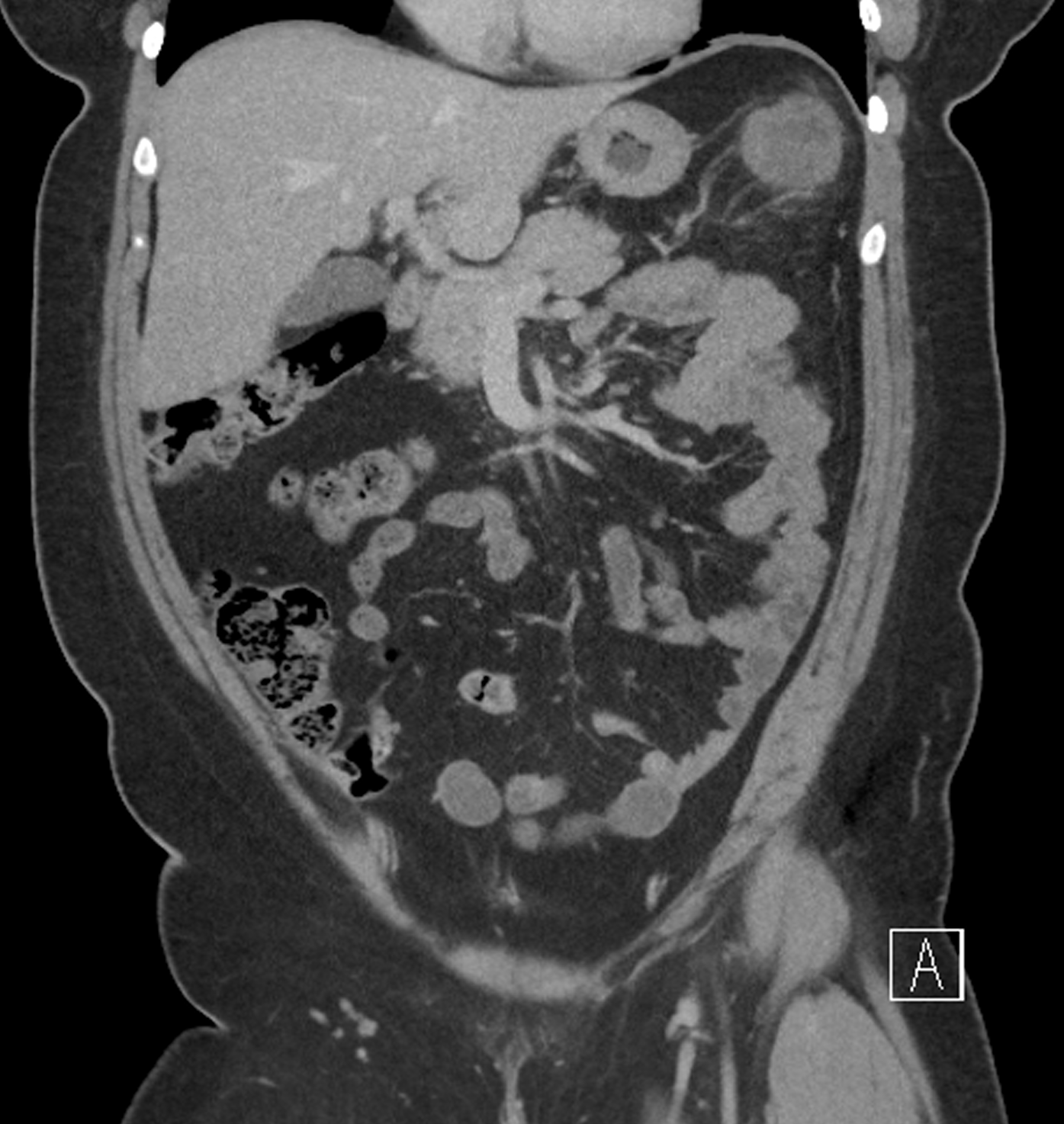Monday Poster Session
Category: Colon
P2495 - Stimulant-Induced Ischemic Colitis
Monday, October 27, 2025
10:30 AM - 4:00 PM PDT
Location: Exhibit Hall

Hassan Eidy, DO
Corewell Health
Farmington Hills, MI
Presenting Author(s)
Hassan Eidy, DO, Hussein Bazzy, DO, Josh Steele, DO, Katie Macfarlane, DO
Corewell Health, Farmington Hills, MI
Introduction: Ischemic colitis (IC) is a recognized entity with variable etiologies, often has a self-limited course, although at times can be fatal. Cardiovascular and thrombotic etiologies are most common, with p</span>harmacologic agents rarely being implicated. Prescription amphetamines are rarely reported as a cause of IC, with prior cases citing inappropriate or illicit use. We present a case of IC attributed to prescription amphetamine use.
Case Description/
Methods: A 30 y.o. female with a history of ADHD presented with lower abdominal cramping pain of 3-day onset. Her pain was associated with nausea, vomiting, and hematochezia. Physical examination revealed left lower quadrant abdominal tenderness to palpation associated with rebound and guarding. Initial laboratory testing showed a WBC of 14.9 k/L, lactic acid of 1.4 mmol/L, C-reactive protein of 67 mg/L, lactic acid 1.4 mmol/L and fecal calprotectin of 232 mcg/g. A computed tomography (CT) scan of the abdomen revealed segmental colonic wall thickening and inflammatory changes, particularly notable at the splenic flexure through the descending colon (figure 1). A colonoscopy was performed, which revealed erythema, ulceration, and edema at 50-65 cm from the anal verge, suspicious for ischemic colitis. Pathology from biopsies were significant for ulceration, laminar propria hemorrhage, withered crypts, and mucin depletion, confirming ischemic colitis. A hypercoagulable workup was unremarkable. In the absence of significant cardiac history and unremarkable hypercoagulable workup, the likely etiology of this patient’s ischemic colitis was attributed to her prescription stimulant medications. Of note, she had transitioned from lisdexamfetamine (Vyvanse) to amphetamine-dextroamphetamine (Adderall) one month prior for management of ADHD. The patient made a full recovery without complication.
Discussion: IC often presents in patients between the ages of 60-70 with a history of atherosclerotic disease. Exclusion of typical etiologies of IC is needed before medications can be attributed as the causative agent. We present a young female with IC thought to be secondary to prescription Adderall use, in the absence of cardiovascular disease or hypercoagulable risk factors. The mechanism by which amphetamines contribute to IC is thought to be due to their vasoconstricting properties from excessive catecholamine release. All etiologies should be considered when evaluating patients with IC, including adverse effects of prescription medications or illicit drug use.

Figure: Coronal image from a CT of the abdomen and pelvis with IV contrast that demonstrates circumferential wall thickening of the colon at the splenic flexure with associated mild peri-colonic fat stranding. Not captured on this single slice image is that these findings involve a longer segment of the colon including an entirety of the splenic flexure.
Disclosures:
Hassan Eidy indicated no relevant financial relationships.
Hussein Bazzy indicated no relevant financial relationships.
Josh Steele indicated no relevant financial relationships.
Katie Macfarlane indicated no relevant financial relationships.
Hassan Eidy, DO, Hussein Bazzy, DO, Josh Steele, DO, Katie Macfarlane, DO. P2495 - Stimulant-Induced Ischemic Colitis, ACG 2025 Annual Scientific Meeting Abstracts. Phoenix, AZ: American College of Gastroenterology.
Corewell Health, Farmington Hills, MI
Introduction: Ischemic colitis (IC) is a recognized entity with variable etiologies, often has a self-limited course, although at times can be fatal. Cardiovascular and thrombotic etiologies are most common, with p</span>harmacologic agents rarely being implicated. Prescription amphetamines are rarely reported as a cause of IC, with prior cases citing inappropriate or illicit use. We present a case of IC attributed to prescription amphetamine use.
Case Description/
Methods: A 30 y.o. female with a history of ADHD presented with lower abdominal cramping pain of 3-day onset. Her pain was associated with nausea, vomiting, and hematochezia. Physical examination revealed left lower quadrant abdominal tenderness to palpation associated with rebound and guarding. Initial laboratory testing showed a WBC of 14.9 k/L, lactic acid of 1.4 mmol/L, C-reactive protein of 67 mg/L, lactic acid 1.4 mmol/L and fecal calprotectin of 232 mcg/g. A computed tomography (CT) scan of the abdomen revealed segmental colonic wall thickening and inflammatory changes, particularly notable at the splenic flexure through the descending colon (figure 1). A colonoscopy was performed, which revealed erythema, ulceration, and edema at 50-65 cm from the anal verge, suspicious for ischemic colitis. Pathology from biopsies were significant for ulceration, laminar propria hemorrhage, withered crypts, and mucin depletion, confirming ischemic colitis. A hypercoagulable workup was unremarkable. In the absence of significant cardiac history and unremarkable hypercoagulable workup, the likely etiology of this patient’s ischemic colitis was attributed to her prescription stimulant medications. Of note, she had transitioned from lisdexamfetamine (Vyvanse) to amphetamine-dextroamphetamine (Adderall) one month prior for management of ADHD. The patient made a full recovery without complication.
Discussion: IC often presents in patients between the ages of 60-70 with a history of atherosclerotic disease. Exclusion of typical etiologies of IC is needed before medications can be attributed as the causative agent. We present a young female with IC thought to be secondary to prescription Adderall use, in the absence of cardiovascular disease or hypercoagulable risk factors. The mechanism by which amphetamines contribute to IC is thought to be due to their vasoconstricting properties from excessive catecholamine release. All etiologies should be considered when evaluating patients with IC, including adverse effects of prescription medications or illicit drug use.

Figure: Coronal image from a CT of the abdomen and pelvis with IV contrast that demonstrates circumferential wall thickening of the colon at the splenic flexure with associated mild peri-colonic fat stranding. Not captured on this single slice image is that these findings involve a longer segment of the colon including an entirety of the splenic flexure.
Disclosures:
Hassan Eidy indicated no relevant financial relationships.
Hussein Bazzy indicated no relevant financial relationships.
Josh Steele indicated no relevant financial relationships.
Katie Macfarlane indicated no relevant financial relationships.
Hassan Eidy, DO, Hussein Bazzy, DO, Josh Steele, DO, Katie Macfarlane, DO. P2495 - Stimulant-Induced Ischemic Colitis, ACG 2025 Annual Scientific Meeting Abstracts. Phoenix, AZ: American College of Gastroenterology.
